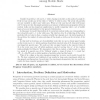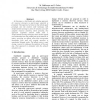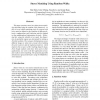214
Voted
ECCV
2010
Springer
15 years 6 months ago
2010
Springer
Graph matching is an essential problem in computer vision and machine learning. In this paper, we introduce a random walk view on the problem and propose a robust graph matching al...
134
click to vote
ADHOCNOW
2004
Springer
15 years 6 months ago
2004
Springer
Consider k particles, 1 red and k −1 white, chasing each other on the nodes of a graph G. If the red one catches one of the white, it “infects” it with its color. The newly ...
137
click to vote
MSWIM
2006
ACM
15 years 6 months ago
2006
ACM
In recent years different authors have proposed the used of random-walk-based algorithms for varying tasks in the networking community. These proposals include searching, routing...
INFOCOM
2006
IEEE
15 years 6 months ago
2006
IEEE
— While structured P2P systems (such as DHTs) are often regarded as an improvement over unstructured P2P systems (such as super-peer networks) in terms of routing efficiency, it...
CIMCA
2006
IEEE
15 years 6 months ago
2006
IEEE
In this paper, a distributed and adaptive approach for resource discovery in peer-to-peer networks is presented. This approach is based on the mobile agent paradigm and the random...
125
Voted
AIRWEB
2007
Springer
15 years 7 months ago
2007
Springer
Link spam deliberately manipulates hyperlinks between web pages in order to unduly boost the search engine ranking of one or more target pages. Link based ranking algorithms such ...
104
Voted
INFOCOM
2007
IEEE
15 years 7 months ago
2007
IEEE
Abstract—It may not be feasible for sensor networks monitoring nature and inaccessible geographical regions to include powered sinks with Internet connections. We consider the sc...
64
Voted
ICPR
2008
IEEE
15 years 7 months ago
2008
IEEE
This paper presents a novel two-phase stereo matching algorithm using the random walks framework. At first, a set of reliable matching pixels is extracted with prior matrices de�...
121
Voted
ACCV
2009
Springer
15 years 7 months ago
2009
Springer
Abstract. In this paper, we propose an efficient method for finding consistent correspondences between two sets of features. Our matching algorithm augments the discriminative pow...
129
click to vote
INFOCOM
2009
IEEE
15 years 7 months ago
2009
IEEE
Abstract—Stateless opportunistic forwarding is a simple faulttolerant distributed approach for data delivery and information querying in wireless ad hoc networks, where packets a...




